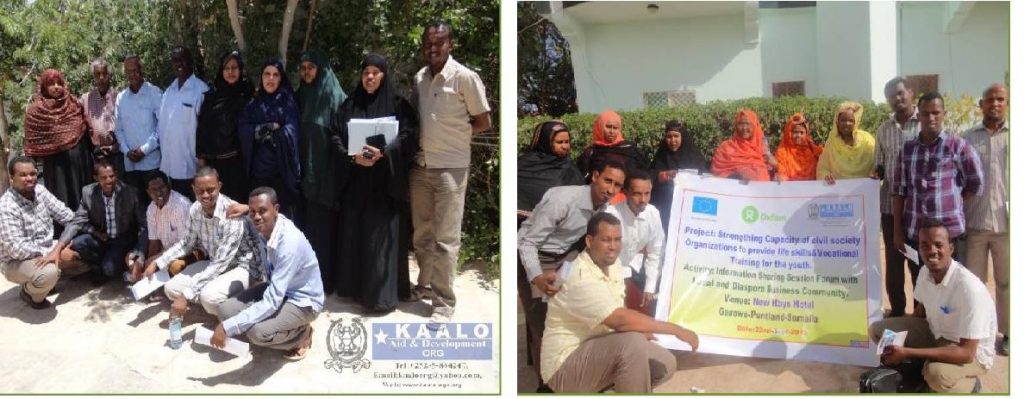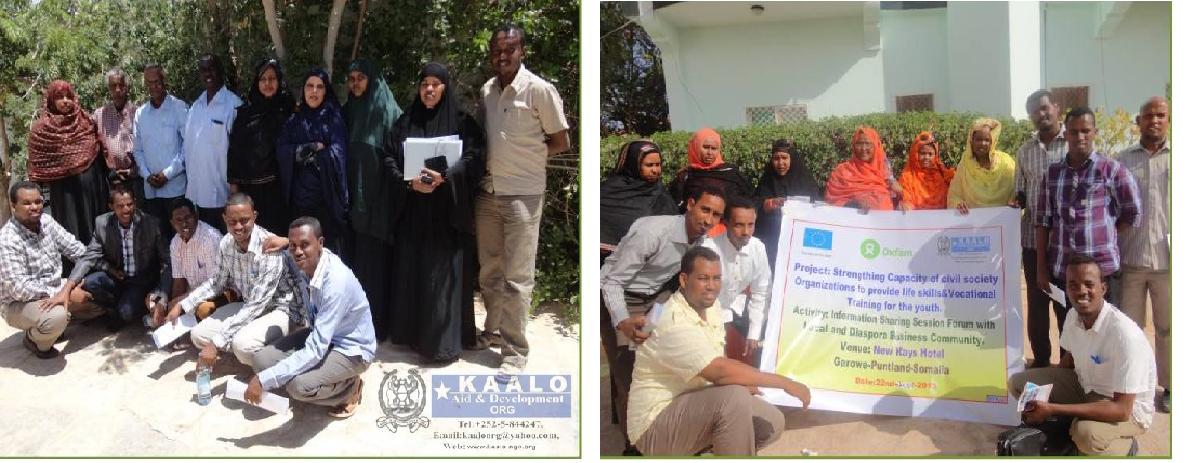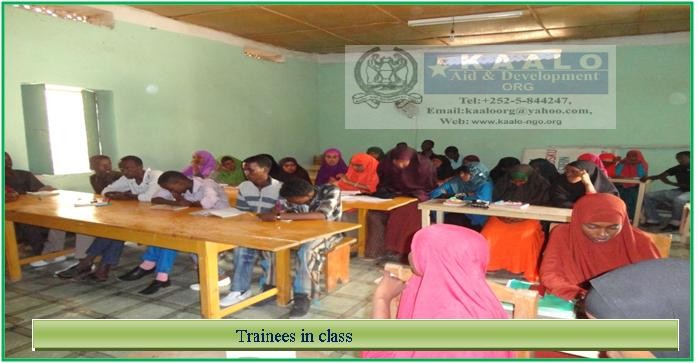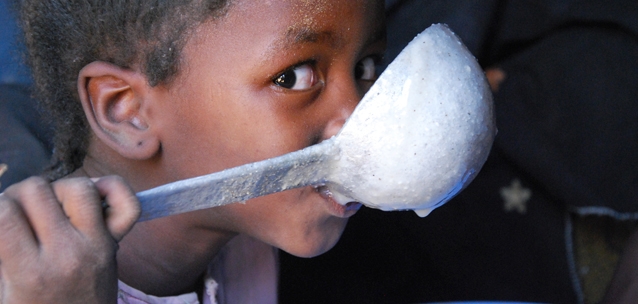August 2013
Kaalo TVET Sector
Strengthening Program Phase
Progress report on Mid Evaluation and 2n session
Acknowledgement
KAALO takes this opportunity to express its profound gratitude to the all who took part in the initiation of this particular project. The first recognition is accorded to the funding partner, the Oxfam Novib who without their intervention this project wouldn’t have happened. We are therefore greatly indebted to them and the success of the project can be directly attributed to the Oxfam Novib
Special recognition and gratitude is also dispensed to the participants who attend the workshop and thereby acquire the invaluable skills imparted to them by the KAALO and 5 CSOs presenters. Of worthy mention is also the authorities of Garowe municipality who accorded us all the support we needed in the facilitation of the project. Last but not least, the KAALO staff who tirelessly worked to ensure the success of the workshop are hereby acknowledged and appreciated.
Table of content
1.0. Acknowledgement………………..……………………………………………………………………………….1
2.0. Table of content……………………………………………………………………………………………………2
3.0. Acronyms and Abbreviations……………………………………………………………………………………..3
4.0. Executive summary…………………………………………………………….………………………………….3
5.0. Introduction………………………………………………………………………….…………………………….3
6.0. Activities…………………………………………………………………………..………………………………4
7.0. Translation of Modules …..……………………………………..…………………………………………………4
7.1. Distribution of the Visibility Items “Banners+ Roll ups”………………………………………………………….4
7.2. Printing and Distributing the Somali Version of the “Donor Matrix Report”…………………………..…………4
7.3. 2nd Information Sharing Session………………………………………………………………………..…………4
7.4. Preparation for second batch…………………………………………………………………………….…………5
7.5. Mid Term Evaluation…………………………………………………………………………………..…………..6
8.0. Achievements………………………………………………………………………………………………………7
9.0. Lessons learnt………………………………………………………………………………………………….…..8
10.0. Challenges……………………………………………………………………………………………….……8
1.0 Recommendations……………………………………………………………………………………………….…
Acronyms and Abbreviations
2.0 KAD Kaalo Aid and Development
3.0 GECPD Galkayo Education Center for peace and democracy
4.0 SWC Somali Women Concern
5.0 TIDES Timely integrated Development service
6.0 PUHRA Puntland Human Rights
7.0 MOLYS Ministry of labor youth and sports affairs
Executive Summary
8.0 This report presents findings of the Mid Evaluation of Kaalo Aid and Development funded – Oxfam TVET Sector Strengthening capacity of civic society organization to provide life skills and vocational training to youth Program Phase I conducted February 2012, ending soon on October and focuses on the Program’s contribution to its intended long term outcomes as specified in the Program of Monitoring and Evaluation.
Introduction
9.0 Education is acknowledged as a means for transforming and empowering communities. The youth especially gain skills, knowledge and attitudes to enable them become productive members of the society. Education contributes to sustainable development, and is recognized in Puntland as a priority area of development intervention as is reflected in policy documents. The Government of Puntland has developed key policy documents over the last years; Poverty this emphasize the importance of education in development.
10.0Technical and vocational education (TVET) is broadly defined as “Education which is mainly to lead participants to acquire the practical skills, knowhow and understanding, and necessary for employment in a particular occupation, trade or group of occupations. Such practical skills or knowhow can be provided in a wide range of settings by multiple providers both in the public and private sector. the role of Oxfam Novib funded TVET in furnishing skills required to improve productivity, raise income levels and improve access to employment opportunities has been widely recognized. Developments in the last six months have made the role of TVET more decisive; the globalization process, technological change, and increased competition due to trade liberalization necessitates requirements of higher skills and productivity among workers in both modern sector firms and Micro and Small Enterprises. Skills development encompasses a broad range of core skills (journalism, communication, financial and secretarial) so that individuals are equipped for productive activities and employment opportunities (wage employment, self-employment and income generation activities).
The skills development is important for economic growth, poverty alleviation, youth and women’s empowerment and social inclusion. Nevertheless, the role of TVET is absent to a large extent in most policy documents. Due to this Oxfam Novib funded a TVET project through KAALO Aid and development which has a working hand with more than five CSOs in Puntland state of Somalia which lent a hand more than six hundred children from poor households that cannot afford to pay their education with free life vocational skills that are marketable in their localities.
Activities
Translation of Modules
Consultants were hired to translate English to Somali the modules provided by Oxfam Novib for the TVET trainers and trainees to simplify the work and for them to understand more deeply in their own language.
Copies of these modules were printed and evenly distributed to the five CSOs and Kaalo TVET sector to use for the effective training on the life skills.
Distribution of the Visibility Items “Banners+ Roll ups”
Banners and roll up for visibility purpose of the five CSOs project was disturbed squarely this will serve the organization that runs TVET project activities to be visible to the public or the community at large
Printing and Distributing the Somali Version of the “Donor Matrix Report”
Printing was done by Kaalo and distributed to five CSOs accordingly; it was a great opportunities to have Somali version report.
2nd Information Sharing Session
The second information sharing session was conducted for the local business and Somali Diaspora, with the aim to put in place a sort of network among the Somali Diaspora, local business community, Six CSOs with vocational centers funded by Oxfam Novib and government of Puntland.
In the workshop gathering the six organizations presented their development work in their vocational centers, these helped the local business community and the Somali Diaspora in the session to understand more the work of these six CSOs towards reducing unemployment rate,
The government representatives, the members of the Diaspora and local business community were contented with the practical life skills trainings carried out the CSOs with the support of Oxfam Novib.
The Diaspora members promised to bring back the knowledge they attained outside, they mentioned lack of uniting mechanism among them and need a welcoming hand from brothers and sisters of the local business community for more networking.
The information sharing was very impressive and the attendees appreciated the work of Oxfam through the CSOs
Participant in the workshop
Preparation for second batch
- Findings, Selection and admission of Student
For the second batch selection and admission for the student was follow as shown,
- Advertisement was made through media; hardcopy was fixed to all billboards around the town and also in front of the office.
- The entire selected student had to completed primary school education before they joined the course he or should produce certificate or leaving for primary school.
- Application letter that written course that one need to study
- Inter-Exam
- For One to be taken he/she has to know how to write and read
- Many of CSO ware encourages school dropouts
- Age -15-35
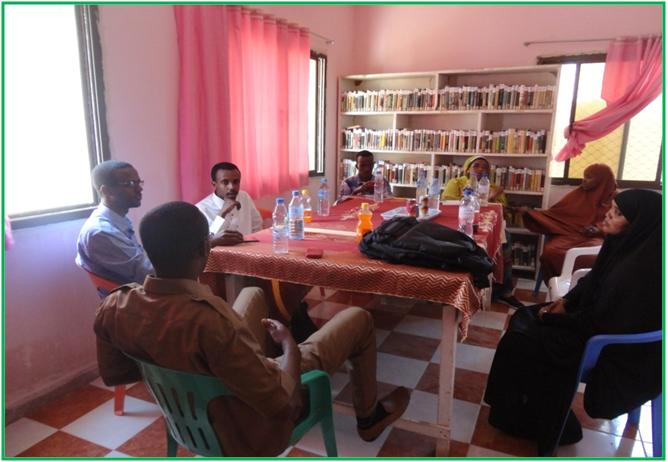 During evaluation
During evaluation
Mid Term Evaluation
Methodology of evaluation
Review methodology included field visits, participant observation in project events, and a series of stakeholder consultations, individual interviews and focus group discussions, including the feedbacks of major stakeholders. Evidence accumulated and feedback generated led to the following findings.
Main findings and conclusion
Taking into account the challenges of the development context, the amount that has already been achieved by the project mid-term stage is impressive. This includes the high levels of stakeholder consensus that have been built up and are being maintained, and the abundance and quality of materials generated together with best practices introduced. The project is among the very few development efforts in Puntland that exemplify a strong and active partnership among key stakeholders:
During evaluation
Achievements
- Successful selection of three hundred second phase students
- Job placement, 10 girls already working with private beauty salon in Galkaio.
- with the help of Child Aid Somali TVET project the students under journalism course in Galckaio formed their own journalist network with name (Mudug women journalism)
- Fair and equitable access to TVET programs is available for all;
- Marginalized groups such as girls and women, the disabled, as well as the rural and urban poor are actively encouraged to develop their skills

- Our visit in one of the vocational center Lessons learnt
- Trainees are more competence by in their own language to study.
- Students understand much in practical class
Challenge
- Most of the applicants were illiterate
- Changes of work plan schedule for unreasonable excuses i.e. during selection
Recommendations
Vocationalzation of general education would help integrate students into the work force and expose them to a range of skills and experiences from everyday life. The main recommendations of the organization are:
- Establishing more linkages between TVET and other sectors
- Better coordination between the formal and informal training systems
- Higher private sector participation
- Orienting TVET towards sustainable development
Conclusion
In conclusion, the Program has achieved measureable and impressive success in meeting its nominated long-term outcomes. Its focal areas cover critical productive sectors while emphasizing environmental sustainability and social inclusion. Fuller engagement of some departments and sectors, processes and trainers capacity to better meet demand, improvements simplify the next phase (and for the sector overall). However, Program centers of skill at all level, and its key provincial stakeholders, should be gratified with the effectiveness of their hard work over this timeframe.

